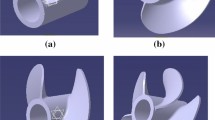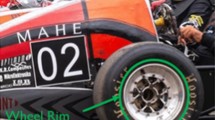Abstract
Though the bulk of marine propellers are almost exclusively manufactured in metal alloys, there has been a recent trend to look into composite materials for propellers. Carbon fibre because of its extremely high strength and favourable strength-to-weight ratio is therefore a strong candidate as an alternate material for propellers. This paper investigates the design, analysis and basic strength aspects of a carbon composite propeller for application as a podded propulsion unit. Propellers are roto-dynamic machines and are prone to fatigue, and therefore, this is one of the important considerations in the choice of the material. Therefore, long-term study in terms of not only strength, hydrodynamic performance, but also fatigue properties must be well established if carbon composite propellers are to be used as substitute for the conventional propellers. This study presents the design of a propeller based on favourable stacking orientation of the multiple layers using unidirectional carbon fibre and epoxy resin, technique of manufacture and test results for hydrodynamic performance. For this purpose, the propeller conforms to standard NACA profiles for high efficiency. The study reports the analysis for strength on the basis of modelling the layer sequence and assigning the directional properties for the carbon fibre. To validate the results, a segmented loading frame has been designed and the deflections measured in the radial direction. The results help to verify the deflections obtained and therefore to confirm the analytical approach to obtain the dynamic stresses and the deflections. The study lays the foundation for redesigning the propeller making full advantage of the strength-to-weight ratio of carbon composite to obtain high efficiency and to obtain the hydro-elasticity-based response characteristic.
Access this chapter
Tax calculation will be finalised at checkout
Purchases are for personal use only
Similar content being viewed by others
Abbreviations
- CFRP:
-
Carbon fibre reinforced plastic
- MRF:
-
Moving reference frame
- η 0 :
-
Open water efficiency
- K T :
-
Thrust coefficient
- K Q :
-
Torque coefficient
- n :
-
Propeller rpm
- V A :
-
Speed of advance
- d :
-
Propeller diameter
- ρ :
-
Density of water
- T :
-
Thrust
- Q :
-
Torque
References
Krucinska I (1991) Evaluation of the intrinsic mechanical properties of carbon fibres. Compos Sci Technol 41(3):287–301
Gilchrist MD, Kinloch AJ, Matthews FL (1996) Mechanical performance of carbon-fibre and glass-fibre-reinforced epoxy I-beams: II. Fractographic failure observations. Compos Sci Technol 56(9):1031–1045
Sun CT, Wanki Jun A (1994) Compressive strength of unidirectional fiber composites with matrix non-linearity. Compos Sci Technol 52(4):577–587
Young YL (2007) Hydroelastic behavior of flexible composite propellers in wake inflow. In: 16th international conference on composite materials, Kyoto, Japan
Young YL (2008) Fluid-structure interaction analysis of flexible composite marine propellers. J Fluids Struct 24:799–818
Lin HJ, Lai WM, Kuo YM (2010) Effects of stacking sequence on nonlinear hydroelastic behavior of composite propeller blade. J Mech 26(03):293–298
Blasques JP, Berggreen C, Andersen P (2010) Hydro-elastic analysis and optimization of a composite marine propeller. Marine Struct 23(1):22–38
Hara Y, Yamatogi T, Murayama H, Uzawa K, Kageyama K (2011) Performance evaluation of composite marine propeller for a fishing boat by fluid-structure interaction analysis. In: 18th international conference on composite materials, Jeju Island, Korea, pp 1–6
Paik BG, Kim GD, Kim KY, Seol HS, Hyun BS, Lee SG, Jung YR (2013) Investigation on the performance characteristics of the flexible propellers. Ocean Eng 73:139–148
Das HN, Kapuria S (2016) On the use of bend-twist coupling in full-scale composite marine propellers for improving hydrodynamic performance. J Fluids Struct 61:132–153. https://doi.org/10.1016/j.jfluidstructs.2015.11.008
Lin H, Lin JJ, Chuang TJ (2005) Strength evaluation of a composite marine propeller blade. J Reinf Plast Compos 24:1791–1807. https://doi.org/10.1177/0731684405052199
Author information
Authors and Affiliations
Corresponding author
Editor information
Editors and Affiliations
Rights and permissions
Copyright information
© 2019 Springer Nature Singapore Pte Ltd.
About this paper
Cite this paper
Kumar, A., Lal Krishna, G., Anantha Subramanian, V. (2019). Design and Analysis of a Carbon Composite Propeller for Podded Propulsion. In: Murali, K., Sriram, V., Samad, A., Saha, N. (eds) Proceedings of the Fourth International Conference in Ocean Engineering (ICOE2018). Lecture Notes in Civil Engineering, vol 22. Springer, Singapore. https://doi.org/10.1007/978-981-13-3119-0_13
Download citation
DOI: https://doi.org/10.1007/978-981-13-3119-0_13
Published:
Publisher Name: Springer, Singapore
Print ISBN: 978-981-13-3118-3
Online ISBN: 978-981-13-3119-0
eBook Packages: EngineeringEngineering (R0)




